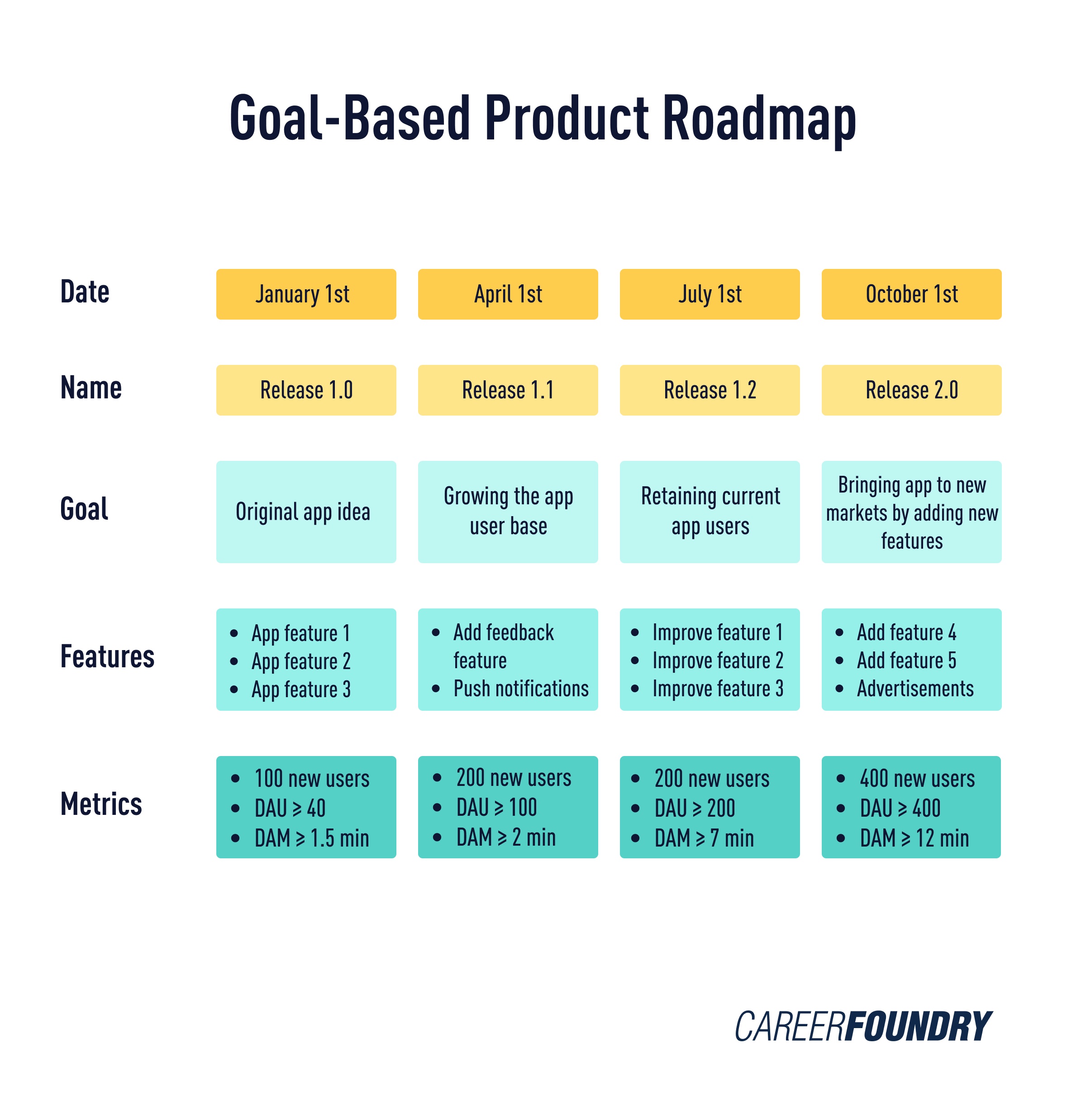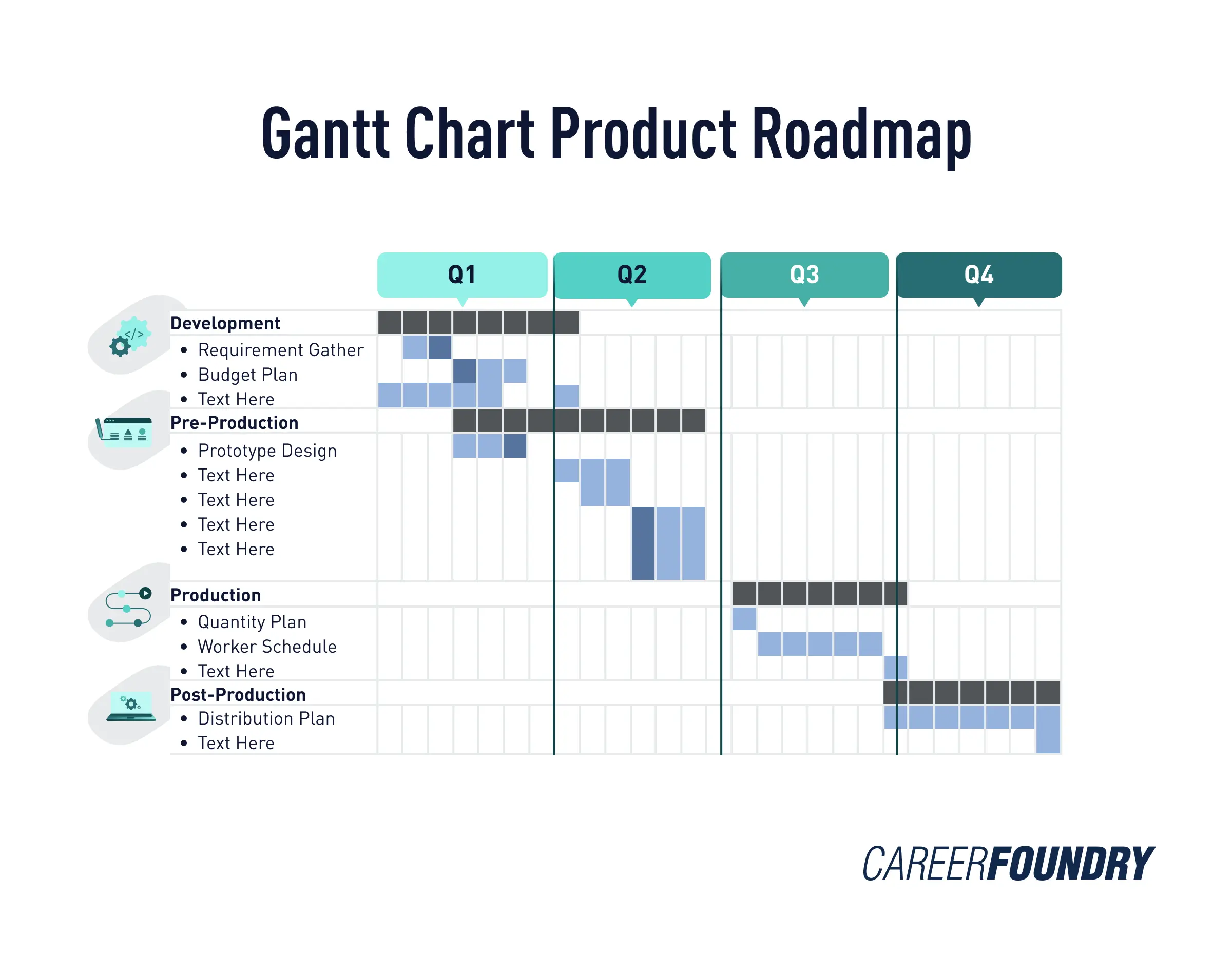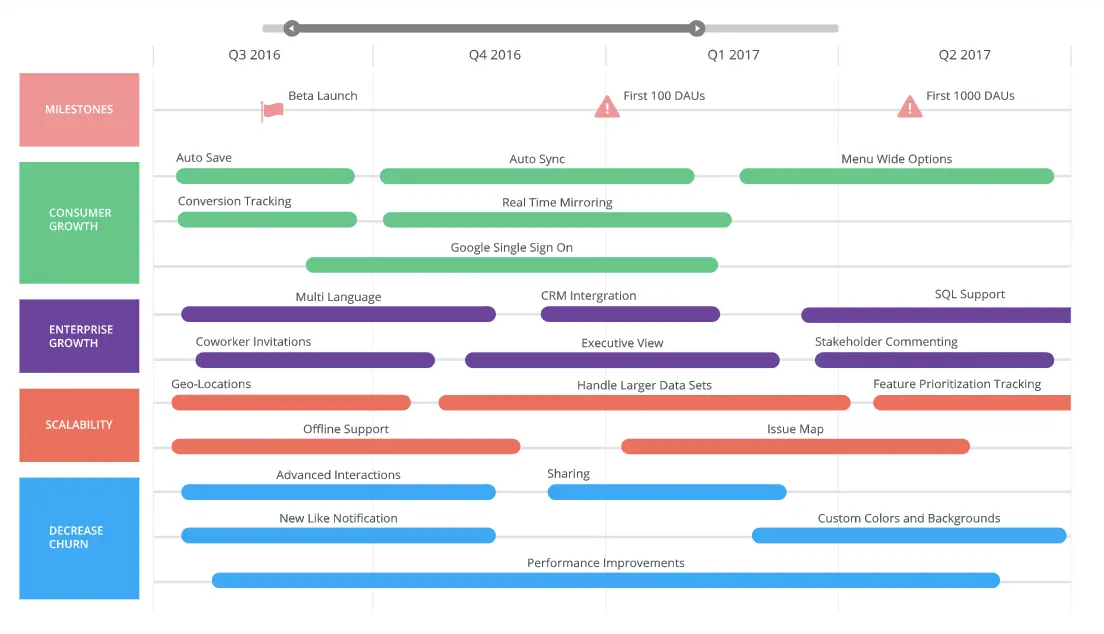Creating and maintaining a successful product is no mean feat. It involves balancing a product’s strategic aims with the needs of its end users, as well as the expectations of internal stakeholders.
Successfully juggling these tasks requires a solid plan. And this is where product roadmaps have a vital role to play.
A product roadmap is a powerful tool that allows product managers to outline a project’s development. It provides oversight of an ongoing project and is the basis upon which time, budget, and resources are assigned to get things done.
But what exactly does a product roadmap look like? How would you go about creating one? In this post, we’ll answer all your burning questions. When you’re finished reading, you should have everything you need to get started with this vital product management tool.
We’ll cover:
- What is a product roadmap?
- Types of product roadmap
- Product roadmap examples
- How to create a product roadmap
- Where to find product roadmap templates
So without any further fuss, let’s dive right in, shall we?
1. What is a product roadmap?
A high-level, strategic tool, a product roadmap is used to describe the vision and direction of a product or service. It outlines the product’s envisioned features and functions and the expected time period over which these will be delivered.
A product roadmap aims to communicate a common strategy and direction to an organization’s stakeholders. Because they are comparatively high-level (as opposed to strategy documents, which focus on the granular tasks required during product development) product roadmaps are much more flexible and agile. This means they adapt well to change.
A roadmap usually summarizes product development over roughly 12-18 months and uses clear visuals to display the following elements:
- Product vision: The product vision is a clear, concise statement articulating the overarching goals of your product. It should be ambitious but achievable—something that everyone on the product development team can rally behind.
- Goals/objectives: Objectives outline what the product is trying to achieve. They typically comprise a list of statements aligned with the company’s overall strategy. To ensure they are meaningful, they sometimes follow the project management mnemonic “SMART”. This stands for specific, measurable, attainable, relevant, and time-bound.
- Initiatives: The initiatives describe (at a high level) the cross-functional projects that need to take place to meet the product roadmap’s objectives. While these won’t go into detail, they’re nevertheless useful for providing different team members with oversight of their project responsibilities.
- Timeline: The timeline is a visual representation of the product roadmap. It should outline when each initiative starts and finishes. It’s often color-coded to make it easier to identify the different categories.
- Dependencies: The visual timeline often highlights a project’s dependencies. This is a list of tasks that need completing before the next stage begins. For instance, you might need to develop a particular software component before creating the features that rely on that component.
In addition to these core elements, a product roadmap may contain strategy details and product backlogs (a list of desired second or third-phase features that help prioritize future development). However, this starts to spill over into “strategy document” territory.
For clarity, it helps to think of the roadmap as the “what” of a product, i.e. what is required to achieve your objectives. Meanwhile, strategy documents will detail the “how” of a product, i.e. the specific technical, design, and project management tasks required to produce and roll the product out.
Although separate, a product roadmap and strategy documents will impact one another. The lines between the two are often a little blurred.

Why is a product roadmap important?
You might be wondering: is a product roadmap really necessary? Can I just focus on the strategy documents?
In short, a product roadmap is very much required. It’s vital for the following reasons:
- It helps ensure that everyone is working towards the same goal
- It keeps product teams focused on which aspects of the project are most important
- It helps the product manager prioritize features, tasks, and release timings
- Because it changes as product development progresses, it’s a concise way of keeping stakeholders updated on progress
- It’s essential for tracking and measuring success metrics
While strategy documents are more useful for day-to-day project management, a product roadmap is a fundamental reference tool. In short, you can’t do without one!
2. Types of product roadmap
There are many product roadmaps available, each targeted at different audiences, activities, and projects.
Most are for internal audiences, like product development, executive, sales, and marketing teams. Others are for external communications, helping keep consumers informed about upcoming releases.
In this section, we focus on internal product roadmaps, as these are most important from a product management point of view. Here are some common ones you might encounter:
Release roadmap
A release roadmap provides an overview of upcoming software releases. It’s used as an internal guide and keeps stakeholders updated on a product’s progress.
It typically includes dates for each release and may be organized by date, product, or project. It also contains descriptions of each feature and whether it is in development, testing, or ready for release.
Technology roadmaps
Technology roadmaps outline the major technological milestones required to complete a new product release. It’s usually aimed at production and development teams.
The milestones may align with an organization’s external objectives (such as providing particular customer features) or internal goals (such as deploying a company’s IT strategy).
Marketing roadmaps
A marketing roadmap is a guidance tool used to inform engineering, project, development, or sales teams about product-related marketing activities.
It typically includes a brief description of the product, the target market, and a schedule of planned marketing activities and objectives. For instance, it might include a timeline of digital campaigns and their goals.
While typically created by marketing teams and product managers, the marketing roadmap helps keep wider teams informed about their input into the marketing journey.
Portfolio roadmaps
While individual projects always have a dedicated roadmap, a portfolio roadmap captures the strategy and objectives for a broader suite of products. This suite of products is known as a product portfolio or more commonly a product mix.
Used as a decision-making framework, it helps determine which products to invest in and how to prioritize them. While all product roadmaps should be regularly reviewed and updated, this is particularly important for portfolio roadmaps. That’s because they contain a complex constellation of projects, each with its own dependencies and product management team.
Keeping the roadmap updated ensures each of these teams—who may otherwise work in isolation—can better coordinate their planning.
Strategy roadmap
Many organizations use specific strategy roadmaps to outline their upcoming plans.
While a product roadmap contains plans for selected products or services, a strategy roadmap contains broader activities. This includes changes to an organization’s structure and processes, not just those to its products and services.
While not aimed exclusively at products, a strategy roadmap often includes product planning or feature updates.
Other product roadmaps are available, often customized to an organization’s project processes. However, these are the key categories to be aware of.
3. Product roadmap examples
We’ve covered the theory, but what does a product roadmap look like in practice? Here are three examples of how they can be applied in the real world.
Goal-based product roadmap
The following roadmap uses a goal-based approach to keep everyone focused on the most vital aspects of product development.
Namely, the goals, the features that are being developed, and the key performance indicators that will measure their success:

By excluding specific development tasks, this kind of roadmap allows product managers and teams more flexibility in reaching their goals.
Goal-based roadmaps are often used for agile projects. Agile is an iterative approach to software development that divides projects into short time periods, known as sprints. Learn more about it in our full guide to Agile product management.
Goal-based roadmaps are ideal here, as they are more flexible and adaptable to change. And because they don’t prescribe specific processes that need following, they allow for more innovation.
Gantt product roadmap
On complex projects, many product managers prefer a timeline-based approach to product roadmaps.
This is particularly useful for projects that must meet certain development standards, or for managing portfolios of products that have many interdependencies.
A Gantt chart product roadmap is ideal here. It provides a visual timeline of the dependency of relationships between different project activities. It’s more prescriptive than a goal-based roadmap.

This sample slide shows how development, pre-production, production, and post-production tasks impact one another.
In this case, it’s also possible to drill down and include specific tasks within each project phase, but this is up to you. How detailed your Gantt product roadmap is will depend on your preferences and the complexity of your project.
Feature product roadmap
While feature roadmaps don’t always have detailed timelines, they are useful for communicating how a product is expected to evolve. A feature roadmap keeps production teams focused on high-level tasks.

Source: Roadmunk
As this example shows, a features roadmap breaks product development into timelines, but these are not as specific as those on a Gantt chart.
The main thing is that the sections are color-coded, keeping relevant details clear at a glance. In this case, the chart categorizes different feature types and prioritizes the essential ones in order of delivery, from left to right.
4. How to create a product roadmap
Many activities are involved in devising a product roadmap. If you’re new to product management and want to create your first roadmap, here are some tips to get you started:
Step One: Put together a multidisciplinary product team
Before creating the roadmap, you’ll need to put together a cross-disciplinary team. This can include senior management and anyone involved directly in the product’s development.
Naturally, team size will depend on the product you’re producing and your available resources. If you work in a small organization, your team may include all those involved in the project.
If you work in a larger organization, you might want to include representatives from each discipline, e.g. development, testing, sales, etc. As the product manager, your responsibility is to guide discussion and maintain project oversight.
Define your product vision
Once your product development team is in place, the next step is to define your product vision.
In many ways, this is the trickiest aspect of creating a product map. Your vision should be a short statement of intent that aligns with the organization’s corporate goals. However, it also needs to deliver for your target audience. Finally, it must get buy-in from all team members.
Your product vision should be:
- Concise: Keep it as to the point as possible. Ideally, a sentence or two.
- Specific: Be clear about what your objective is. Stay focused.
- Aspirational: Don’t play it too safe—stretch what your team can achieve.
- Actionable: Balance aspiration with realism about what is actually doable.
Finally, your product vision should have clear boundaries. Where does your vision begin and end? There is no space for ambiguity. Keep everyone focused on the task at hand.
What is involved in defining your vision?
While your product vision is a short statement, it requires a lot of input from your team. For example:
- A marketing representative might offer insight into your target audience, their needs, pain points, and how best to differentiate your product from competitors.
- A designer will help determine the product’s specific features and what they should ideally do to support your customers and corporate goals.
- A web or software developer will offer clear guidance on what is practically achievable against the design plan, and how long it should take to achieve each development milestone.
- Finally, a leadership representative will likely have to sign off on the finished product vision to ensure they are happy with it.
Alongside ticking off all these requirements, your vision should be something every team member can sign up for and invest in.
Step Two: Create your product map
Once your team has agreed on a product vision, the next step is to pull all their input into a coherent product roadmap.
This is where your upfront discussions will come in handy, as you will already be able to define the different disciplines’ project responsibilities.
The creation and maintenance of the product roadmap fall to the product manager. It should be high-level while answering key questions:
- What goals do you need to put in place to achieve your vision?
- What specific steps must be taken to achieve these goals, and by which teams?
- What metrics are required to track to measure your product’s success? Examples of metrics could be AARRR (Pirate Metrics)
- How will you gather these metrics?
- Will you create a prototype for your product? If so, what features will it test?
- What timelines and dependencies do the team need to be aware of?
The list can go on, and considerations will vary depending on the product or suite of products you’re creating.
It’s ultimately down to each team member to act as an expert advisor, ensuring your strategy meets everyone’s needs, from business analysis to UX/UI design and technical development.
Your end product map will be a relatively detailed visual timeline of the product development cycle. This includes design and development tasks, including deadlines, budgets, and dependencies.
But remember: This is a working document and isn’t set in stone. Regularly revisit your product roadmap to ensure it’s on track. If budgets shift or the project scope changes, adjust your roadmap accordingly.
Step Three: Share your product roadmap
Finally, you’ll need to ensure that everyone involved in the product development process understands the roadmap and their responsibilities.
Share the roadmap with your immediate team, broader stakeholders, and if appropriate, your customers. Make sure they all understand their responsibilities and field any questions they might have.
As you learn more about your market or the development lifecycle, you may need to update your roadmap and keep stakeholders informed. It helps to store it in a central location where anybody can access the changes.

5. Where to find product roadmap templates
Devising a product roadmap is a key part of a product manager’s role. But it’s far from their only responsibility.
Creating and maintaining spreadsheets, managing budgets, and tackling other project management tasks are time-consuming. Fortunately, there are many places where you can find product roadmap templates to streamline the process for you.
Here are five to get you started:
Smartsheet
Smartsheet is a software-as-a-service (SaaS) collaboration and work management tool. It offers many free product roadmap templates. Available in Excel, Word, and PowerPoint, these templates cover everything from sprint roadmaps to roadmaps for Enterprise IT, consulting, and more.
ProductPlan
ProductPlan is a popular roadmap platform that also offers their own free templates. They have templates available across product management, marketing, engineering, and IT.
These range from UX/UI roadmaps to DevOps and more. You will have to sign up for a trial to access these product roadmap templates.
Roadmunk
Roadmunk is another online software provider designed to help create and share visual product roadmaps that your entire team can collaborate on.
Sign up for a trial and Roadmunk offers several free templates for various development methodologies including Scrum, lean and agile. They come with excellent user guides.
Aha!
Aha! provides SaaS tools that allow organizations to devise strategies, share ideas, plan, build and launch new products. Sign up for a free trial and you can explore over a dozen different product roadmap templates.
Trello
The collaborative project management tool, Trello, is built on a Kanban-style project management methodology (Kanban being a popular agile and DevOps software framework). Sign up for a free trial to access their ideas, planning, research, and design templates.
Even if you choose to design and manage your own roadmap from scratch, exploring some of these templates will certainly help provide some much-needed inspiration.
6. Next steps
There we have it, product roadmaps 101!
In this post, we’ve explored everything you need to know about product roadmaps. You should now be able to create a compelling one for your business.
Start by understanding the needs of your customers and broader team. Then, build your product roadmap and share it with your stakeholders. Finally, you’ll be ready to devise a more detailed strategy document and start working towards your product goals.
If you found this topic interesting and want to learn more about a career as a product manager, why not sign up for this free Product Management for Beginners course?
Alternatively, check out the following guides to learn more:
